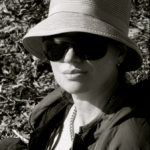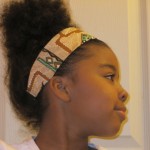How do you store your cut pattern pieces?
-
13 years ago LINK
 katybellabug
@katybellabug
katybellabug
@katybellabug
I have quite a few patterns cut out in different sizes now and at the moment they are put into their own plastic wallet and kept together with the original pattern sleeve. However, it all looks a bit messy and my pile gets scruffier the more I rummage through it. So I was wondering how everybody else organized their own patterns and pieces.
Any tips?
13 years ago LINK Jane
@jesims
Jane
@jesims
I use a binder with clear plastic pages to keep everything together. It is a little bulky so I too would be interested to see if there is a better solution.
13 years ago LINKJenny @Jenny
On a related note, I’m always intrigued by how so many of you with multiple kids manage to use the same pattern over and over in different sizes. Is it as simple as making a tissue copy of each size and leaving the original uncut? And then how do you organize those, along the lines of the questioners above?
I once made a batch of sailboat tops and pants/skirts for my daughter’s cousins, and thought it would be as easy as cutting the size 6 first, then the 5, then the 4….of course I forgot that things could get messy along curves, so I was doing a ton of on-the-spot tracing and I was nervous the whole time.
13 years ago LINKJenny @Jenny
Whoops, I see that this topic has been covered pretty extensively a thread or two down–and I am humbled by the many strains of organizational genius on display there.
13 years ago LINK beachmom
@beachmom
beachmom
@beachmom
I trace each size off as I need it, pin all the pieces for each respective size together, and then stick those in a manila folder that goes into a plastic box for storing hanging files.
I got in the habit of tracing with all the Ottobre Design magazines I sew from. It’s a great way to preserve the original pattern.
13 years ago LINK katybellabug
@katybellabug
katybellabug
@katybellabug
Thanks beachmom. I think I need a trip to Ikea! I remember my first glance at the Ottobre pattern sheets. I thought they looked like complicated blueprints at first! My way of dealing with them was to lay them out flat on the floor and take a big step back to get my bearings. Otherwise I get a bit overwhelmed with all the multicoloured lines!!
13 years ago LINK Nicole
@motherof5
Nicole
@motherof5
I used to use TopKids,very similar to Ottobre. I had some fine tipped fluro pens which I used to outline the pattern I wanted before tracing.
That helped me a lot. I still do it with the fiddly o+s pattern pieces.
~Nicole~
13 years ago LINKSherry @mim22
I trace the different sizes with different coloured pens, that way if a size 2 pattern piece gets muddled in with a size 5 piece you can find it quickly.
After they are traced I store them in a large envelope in a folder, with a photocopy of the outfit glued to the front of the envelope and also a list of what sizes are traced, and the original stays in its packet on the shelf. Seems to work well for me most of the time, sometimes pieces seem to wander off in search of adventure.
Sherry
13 years ago LINKwith love Heidi @with love Heidi
I trace off all my patterns, usually onto baking paper (as thats the best thing in my house) or for larger pieces I got an end of roll news print paper (only $3!). To store them I have one folder/file (called display books) per pattern. Each size I trace off gets put in its own pocket and I only put one garment pattern in a pocket (if there’s a skirt and top in size 4 this will be 2 pockets). I try to keep them in size order and would like to eventually label each page/pocket but for the moment I just make sure that the size on one of the pieces is visible. I have labelled them all on the spine and front cover with the company and pattern, for example ‘Oliver + S’ ‘Sandbox’, this means I can quickly and easily pull the one I want from my shelf.
13 years ago LINKkaren @karen
I am a long-time sewer with many patterns. I store all my pattern pieces in manila file folders and glue the picture of the pattern to the front of the folder. I also write the pattern number and company on the file tab.(File folder envelopes are great but more expensive. I simply staple the sides of a regular manila folder and that creates a cheaper version of a pocket.) Then I keep all the folders in a file cabinet.
When I trace a size off a multi-size pattern, I use the grided “fabric” you can get at a fabric store–it has 1″ squares printed all over the fabric (which is more like a web)–these lines really help you with markings like straight of grain, etc. These “fabric” pattern pieces can be used over and over and they rarely rip or tear.
13 years ago LINK katybellabug
@katybellabug
katybellabug
@katybellabug
So many great ideas. I really like the thought of colour coding all the sizes regardless of pattern. Makes it easy at first glance.
I am intrigued by the gridded fabric. I have a large, very large, sheet of MDF that I put over my tabletop when working on big projects (like curtains, blinds…) and I have covered it with a layer of wadding, topped with a layer of muslin so I can pin and iron on it easily. I made the extra effort of drawing 2″ grid squares all over it and sewing over the lines so I could get my corners and edges lined up accurately. It took me ages. I don’t even want to think that I could have saved myself the time and effort and bought it off the roll!
13 years ago LINK LucyM
@LucyM
LucyM
@LucyM
After tracing a pattern piece, I label it with the pattern part (blouse front, pocket facing, etc.), manufacturer, name, and size. I then pile a complete pattern, punch a hole through all the pieces, and thread them through the hook of a hanger and hang them. So far, there is sufficient closet space and my flat surfaces and shelves are free for my insane fabric stash.
13 years ago LINK Frances Suzanne
@Frances Suzanne
Frances Suzanne
@Frances Suzanne
My sister and I just blogged about this exact topic at: http://www.francessuzanne.blogspot.com/2012/07/organization-101-ocd-style.html. Sounds like there are some awesome ideas already shared though….
You must be logged in to reply to this topic.
copyright
Unless otherwise credited, all work on this blog is © Liesl + Co., Inc, 2008-2025. You are welcome to link to this blog, but please ask permission before using any text or images.